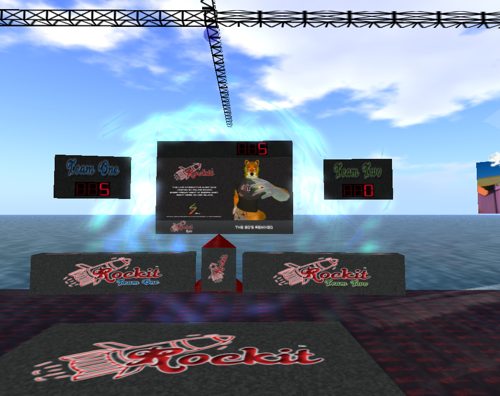1. Forbes (USA) – The Second Life Hype Has Fizzled—Is Twitter Next? “Second Life is still a vibrant virtual world—with over 12.2 million registered users and more than 54,000 online the last time I logged in—but you wouldn’t know it from the media coverage (or lack thereof) lately. It wasn’t always this way, as MediaShift’s Mark Glaser recounts, in a post covering how Second Life’s media hype has fizzled.”
2. Mediashift (USA) – Reuters Closes Second Life Bureau, but (Virtual) Life Goes On. “The sun shines brightly as I stroll along the curving pier above the water, looking out toward a beautiful island with trees swaying in the wind. There’s a looming ampitheater festooned with signs for Thomson Reuters, and a series of concrete buildings that appear ready to hold important meetings. I stride in confidently through the doorway… You might think I was describing a trip to visit Reuters in the UK, but really, I was strolling through the virtual world of Second Life (SL), visiting the Thomson Reuters island, now largely vacant. The island symbolizes the efforts of media companies not only to cover life in the virtual world of Second Life, but also to live there and set up virtual offices. Reuters made waves by setting up a bureau in SL, with reporters Adam Pasick and Eric Krangel covering stories about the virtual currency and the startup businesses springing up in-world.”
3. Computerworld (New Zealand) – Reality is broken so go virtual, says games developer. “Web developers and designers have a lot to gain by looking to the virtual world, because compared to the gaming world, reality is broken, says Jane McGonigal, game designer and director of game research and development at the Institute for the Future, a California-based non-profit research group. People are not as happy and fulfilled in reality as they are in online, virtual realities, such as World of Warcraft, McGonigal told the audience at developer and designer conference Webstock, which kicked off on yesterday in Wellington. ”
4. Telepresence Options (USA) – The Case for 4D Immersive Holographic Spaces. “The United States of America has steadily fallen further and further behind Asian and European nations with respect to broadband penetration and related services. This is impeding the development of new consumer applications (and related new industry and services) and limiting communications in an economy where knowledge exchange is vital in order to be to be a major player of the emerging , seamless and unobstructed global market. Reversing this trend may be of high interest to the incoming administration, but the viability of extending broadband is dependent on the deployment of new high bandwidth and high value applications that (a) will justify the investments required and (b) will contribute digital solutions to many of the key societal problems in this Energy-Climate Era (as recently identified by Thomas L. Friedman in his book Hot, Flat and Crowded) such as growing demand for ever scarcer energy supplies and natural energy, rapid and accelerating biodiversity loss, and disruptive climate change.”
5. Atlanta Journal Constitution (USA) – Gamers want to look rivals in eye. “he scene unfolding one recent Friday evening at Cyberdome in Easton, Pa., couldn’t be sweeter for a group of teenage boys poised for a night out with friends. Teens and tweens, ages 12 to 19, popped open cans of caffeine-loaded Liquid Lightning, slouched into the kind of swivel chairs executives use and centered themselves behind 20-inch screens, the windows into their virtual worlds for the night. “This is Disney World for them,†said Cyberdome’s owner Mark Dressel, who was hosting the all-night video game lock-in for nearly 20 area teens.”
6. Gameplanet (New Zealand) – The Sims 3 Q&A session. “With over a hundred million units shipped to date, you can’t deny that The Sims is one popular franchise.
Developers Maxis started the series nearly a decade ago, after venerable designer Will Wright insisted he could take their immensely popular SimCity series in a new direction and make a “people sim”. The concept of manipulating people sitting in their houses whilst you sat in yours was, perhaps surprisingly, a hit, and even after seven expansions the series is still going from strength to strength.”
7. The Malaysian Star (Malaysia) – Philips extends invitation to its virtual island. “PHILIPS is inviting Malaysians to take a peek at its virtual R&D island located in Linden Lab’s Second Life where virtual concepts are being tested and visitors can participate in co-designing the projects. The company called the island its collaborative working space for the real and virtual worlds, which provides the opportunity to research ideas with creative global early adaptors of new trends. “It fits with the company’s philosophy that design should be based around people and grounded in research,†said Dolf Wittkämper, senior director of Philips Design.”
8. Campus Technology (USA) – Real-Life Teaching in a Virtual World. “Few technologies have been subject to more hype and subsequent disappointment than Second Life. Corporations from shoe manufactures to cruise lines to news services set up shop with hopes this new frontier would bring soaring profits. Most evacuated shortly thereafter when the effort resulted in spaces devoid of audiences and buyers. A notable exception, though, is education. Education is thriving in Second Life. This enthusiastic subculture is abuzz within the Second Life realm, constantly interacting inside and outside Second Life. Educators are exploring every possible tool the 3D virtual world offers and establishing best practices along the way.”
9. Virtual Worlds News (USA) – Interoperability Gaining Steam Again? “In Fall 2007, interoperability was the buzz word surrounding our show in San Jose. IBM had organized a summit of leaders from the industry and announced plans with Linden Lab to work on avatar interoperability. Things died down a bit after that as individuals returned to their own projects, but IBM, Linden, and others continued to work to integrate OpenSim and Second Life, which OpenSim is based on. It looks like things are picking up again, at least for Linden and IBM, which are co-chairing the Internet Engineering Task Force’s Massive Multiplayer Online Experiences working group.”
10. RedOrbit (USA) – Microsoft To Study Educational Benefits Of Video Games. “Devin Krauter sits on the end of his bed, using his video game controller to shoot down aliens while taking with other players through a headset, all the while texting on his cell phone and chatting with a visitor. A video game Web site ranks the 17-year-old high school junior among the best players at “Gears of War 2,” a game in which soldiers fight their enemies using an assault rifle with a mounted chain saw bayonet. Krauter says the game teaches him to think on his feet, and that he thinks about succeeding, not slaying.”
 NoviCraft is one of the more fascinating virtual world business offerings by Finnish company,
NoviCraft is one of the more fascinating virtual world business offerings by Finnish company, 

 I received a media release yesterday, announcing the launch of a virtual TV show,
I received a media release yesterday, announcing the launch of a virtual TV show,  It’s an understatement to say I’m really pleased to announce a further addition to the writing team at The Metaverse Journal.
It’s an understatement to say I’m really pleased to announce a further addition to the writing team at The Metaverse Journal.
Recent Comments